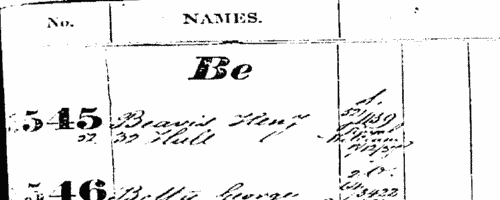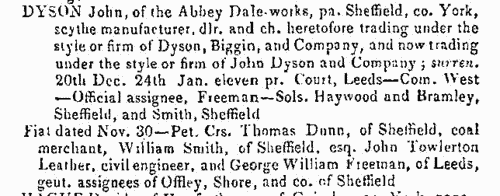Our indexes include entries for the spelling bendle. In the period you have requested, we have the following 58 records (displaying 11 to 20):
Insolvents
(1837)
Insolvency notices for England and Wales: insolvency often caused people to restart their lives elsewhere, so these are an important source for lost links | Sample scan, click to enlarge

|
 British merchant seamen
(1835-1840) British merchant seamen
(1835-1840)
At this period, the foreign trade of ships plying to and from the British isles involved about 150,000 men on 15,000 ships; and the coasting trade about a quarter as many more. A large proportion of the seamen on these ships were British subjects, and so liable to be pressed for service in the Royal Navy; but there was no general register by which to identify them, so in 1835 parliament passed a Merchant Seamen's Registration Bill. Under this act a large register of British seamen was compiled, based on ships' crew lists gathered in British and Irish ports, and passed up to the registry in London. A parliamentary committee decided that the system devised did not answer the original problem, and the original register was abandoned after less than two years: the system was then restarted in this form, with a systematic attempt to attribute the seamen's (ticket) numbers, and to record successive voyages. The register records the number assigned to each man; his name; age; birthplace; quality (S = seaman, &c.); and the name and official number of his ship, with the date of the crew list (usually at the end of a voyage). Most of the men recorded were born in the British Isles, but not all. The system was still very cumbersome, because the names were amassed merely under the first two letters of surname; an attempt was made to separate out namesakes by giving the first instance of a name (a), the second (b), and so on. During 1840 this series of ledgers was abandoned, and a new set started with names grouped together by surname. BT 112/4 | Sample scan, click to enlarge

|
Bankrupts
(1840)
Bankruptcy notices for England and Wales: bankruptcy often caused people to restart their lives elsewhere, so these are an important source for lost links
| Sample scan, click to enlarge

|
Petitioning Creditors and Solicitors
(1842)
Principal creditors petitioning to force a bankruptcy (but often close relatives of the bankrupt helping to protect his assets): and solicitors | Sample scan, click to enlarge

|
Insolvents in Bankruptcy
(1844)
Insolvency in bankruptcy notices for England and Wales: insolvency often caused people to restart their lives elsewhere, so these are an important source for lost links | Sample scan, click to enlarge

|
Petitioning Creditors and Solicitors
(1844)
Principal creditors petitioning to force a bankruptcy (but often close relatives of the bankrupt helping to protect his assets): and solicitors | Sample scan, click to enlarge

|
Prisoners removed from Millbank Prison to the Justitia hulk
(1845)
The new prison at Millbank was used as a holding centre for convicts destined for the hulks: 'few of the adult convicts remain for a longer period than three months; and of those who remain for a longer period, the most part are criminals of the worst description, who are awaiting embarkation for their final destination in Norfolk Island.' The report of the commissioners appointed to inquire into the management of the prison includes a return of the number and general state of health of all prisoners received at the Justitia hulk, Woolwich, from Millbank Prison, from 1 January 1844 to 21 June 1846, giving: Sequential Number; Name; Age; Date of Reception; Disease or Sickness existing at the time of Reception; General state of Health since; Recovered, embarked or otherwise transferred; Died; Date of Decease; Causes of Death.
| Sample scan, click to enlarge

|
Prisoners removed from Millbank Prison to the Justitia hulk
(1843-1846)
The new prison at Millbank was used as a holding centre for convicts destined for the hulks: 'few of the adult convicts remain for a longer period than three months; and of those who remain for a longer period, the most part are criminals of the worst description, who are awaiting embarkation for their final destination in Norfolk Island.' The report of the commissioners appointed to inquire into the management of the prison includes a return of male convicts transferred from the Millbank Prison to the Justitia hulk, from 1 August 1843 to 21 June 1846, giving: Register Number; Name; Number of Reports for Misconduct; Punishment; How long in this prison.
| Sample scan, click to enlarge

|
Boys in Millbank Prison
(1845-1846)
The new prison at Millbank was used as a holding centre for convicts destined for the hulks: 'few of the adult convicts remain for a longer period than three months; and of those who remain for a longer period, the most part are criminals of the worst description, who are awaiting embarkation for their final destination in Norfolk Island.'
The report of the commissioners appointed to inquire into the management of the prison includes a list of boys too small for removal to Parkhurst, giving: Register Number; Name; when and where convicted; Crime; Sentence; date received at Millbank. | Sample scan, click to enlarge

|
Insolvents in bankruptcy in England and Wales
(1846)
Perry's Bankrupt and Insolvent Gazette, issued monthly, included lists of insolvents petitioning the courts of bankruptcy, together with subsequent stages in their discharge. The insolvent is generally referred to by name (surname first, in capitals), address and trade. The initial notice of the petition gives the surnames of the Commissioner and the Official Assignee. This is the index to the names of the insolvents, from the issues from January to December 1846. | Sample scan, click to enlarge

|
Research your ancestry, family history, genealogy and one-name study by direct access to original records and archives indexed by surname.












